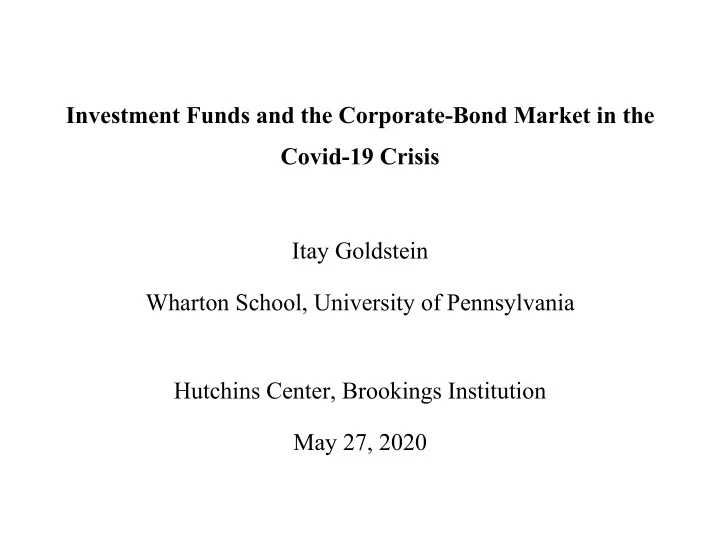

Investment Funds and the Corporate-Bond Market in the Covid-19 Crisis Itay Goldstein Wharton School, University of Pennsylvania Hutchins Center, Brookings Institution May 27, 2020
Itay Goldstein: Corporate-Bond Market in the Covid-19 Crisis Background Investment funds – including mutual funds and ETFs – became a dominant force in the corporate-bond market since the global financial crisis of 2008-2009 Due to liquidity mismatch – holding illiquid assets, but providing high level of liquidity to their investors – they are exposed to “run” type behavior from their investors o Chen, Goldstein, and Jiang (2010); Goldstein, Jiang, and Ng (2017) This has been the focus of major concerns among policymakers, leading to changes in regulation over the last few years o For example, SEC allowing swing pricing in US mutual funds starting in November 2018 Now, following the market turmoil of the Covid-19 crisis, is a good time to examine the fragility of the corporate-bond markets and the investment funds in this time of stress Hutchins Center, Brookings Institution Page 1
Itay Goldstein: Corporate-Bond Market in the Covid-19 Crisis Initial Findings Corporate-bond markets in the U.S. suffered severe stress in March 2020, leading to a dramatic increase in spreads and decrease in liquidity Investment funds in the corporate-bond market experienced massive outflows, which are far greater than anything seen since they became such a major player in the market Flows were sustained for a few weeks across different types of funds (e.g., investment-grade and high- yield); although timing is not the same for all It seems that a couple of policy announcements by the Federal Reserve about direct interventions in corporate-bond markets were crucial for alleviating the stress o March 23: PMCCF and SMCCF; purchase of investment-grade bonds on primary and secondary markets o April 9: Extend PMCCF and SMCCF to $850bn (from less than $300bn); extend SMCCF to purchase high- yield bonds if they were investment-grade as of March 22 I will now show key developments along these lines in a few charts, based on work in progress with Antonio Falato and Ali Hortacsu Hutchins Center, Brookings Institution Page 2
Itay Goldstein: Corporate-Bond Market in the Covid-19 Crisis The Growing Importance of Investment Funds in the Corporate Bond Market (Aggregate Net Asset Value divided by Size of Market) Data Source: Flow of Funds Hutchins Center, Brookings Institution Page 3
Itay Goldstein: Corporate-Bond Market in the Covid-19 Crisis Signs of Stress in Corporate Bond Market over the Crisis Period Data Source: ICE indices High-yield Spreads Investment-Grade Spreads March 23 April 9 March 23 April 9 Hutchins Center, Brookings Institution Page 4
Itay Goldstein: Corporate-Bond Market in the Covid-19 Crisis Long Term Perspective on Monthly Aggregate Net Flows (Fraction of Lagged Net Asset) Data Source: Morningstar Hutchins Center, Brookings Institution Page 5
Itay Goldstein: Corporate-Bond Market in the Covid-19 Crisis Shock Hits Across the Board: Daily Net Fraction of Funds with Large (top decile) Outflows (vs. Inflows) Data Source: Morningstar Hutchins Center, Brookings Institution Page 6
Itay Goldstein: Corporate-Bond Market in the Covid-19 Crisis Funds Face Sustained Outflows: Daily Net Fraction of Funds with Large (top decile) Outflows (vs. inflows) in Two Consecutive Days Data Source: Morningstar Hutchins Center, Brookings Institution Page 7
Itay Goldstein: Corporate-Bond Market in the Covid-19 Crisis Evolution of Flows over the Crisis: Daily Aggregate Net Flows (Fraction of Lagged Net Asset) Data Source: Morningstar March 23 April 9 Hutchins Center, Brookings Institution Page 8
Itay Goldstein: Corporate-Bond Market in the Covid-19 Crisis Tracking the Evolution of Flows across Different Types of Funds (Fraction of Lagged Net Asset) Data Source: Morningstar ETFs High-yield Funds Investment-Grade Funds March 23 April 9 March 23 April 9 March 23 April 9 Hutchins Center, Brookings Institution Page 9
Itay Goldstein: Corporate-Bond Market in the Covid-19 Crisis Tracking the Evolution of Flows across Illiquid vs. Liquid Funds (Measured Based on Price Interquartile Range) Data Source: Morningstar, eMAXX, Trace Liquid Funds (Bottom Quartile) Illiquid Funds (Top Quartile) March 23 April 9 March 23 April 9 Hutchins Center, Brookings Institution Page 10
Itay Goldstein: Corporate-Bond Market in the Covid-19 Crisis Conclusion Investment funds have become dominant in corporate-bond markets and are prone to fragility The Covid-19 crisis imposed severe stress on them leading to massive outflows Massive intervention by the Federal Reserve seems to have been critical for alleviating the problem Going forward, one should not count on such intervention, and the fragilities of the market and the funds have to be investigated Possible policies: o Improving liquidity of underlying corporate bond assets o Reducing liquidity available to investors Swing pricing has only recently been introduced in the U.S. and is not widely adopted yet Evidence from other countries suggests it has been quite effective: Jin, Kacperczyk, Kahraman, and Suntheim (2020) Hutchins Center, Brookings Institution Page 11
Recommend
More recommend